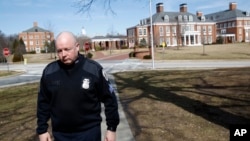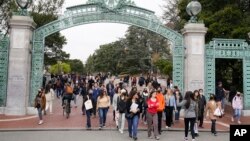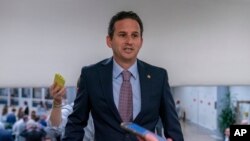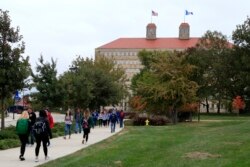Student Union
US College Leaders See Too Much Competition Ahead

A survey of nearly 500 leaders at colleges and universities reflects other reports that found American higher education is facing challenges on many fronts.
School officials were asked to name the biggest issues their institutions would face in the next three to five years and how they would deal with them. The study was a joint effort with the Georgia Institute of Technology and the Huron Consulting Group, and was released in October.
The study identified the top six issues that the 500 leaders listed. The most common concern? Increasing competition with other educational institutions. About 62% of those questioned noted that concern.
The next most common issue? The increase in non-traditional students, meaning students who fall outside the typical 18 and 24 years olds who enter school each year. The growth of non-traditional students – mostly adults with full-time jobs -- were cited by 39% of leaders.
Two other concerns were shrinking state and federal financial support, and decreasing public trust in higher education. Officials said they were worried about political conditions around the world, too, and their effect on international students coming to the United States.
But the college and university officials said they have answers. In fact, 89% expressed confidence in their school’s ability to meet the needs of the growing number of students who are working adults.
Peter Stokes says colleges and universities have always been dealing with change. Stokes is the managing director for higher education with Huron.
After World War II, when the U.S. experience a sharp jump in the U.S. birth rate -- known as the Baby Boom -- more young people enrolled in college. Then, after the Great Recession in 2008, the birth rate dropped. Around that time, the number of working adults starting or returning to college or university began to rise.
The traditional student population will likely recover eventually, Stoke says. Until then, schools will have to adapt and increase internet-based and short-term programs to meet the needs of students who have less time and money to spend.
As for the five other issues identified in the study, only seven leaders polled felt very confident in their school’s ability to find solutions.
Louis Soares is the chief learning officer at the American Council on Education. He says that in recent years, Americans have come to think of higher education as more of a means of getting a well-paying job than as a public benefit.
This may not be surprising given the increased cost of higher education. But Soares said that this put many educational institutions in competition with one another to prove how their programs can results in better jobs.
At the same time, U.S-based companies like Amazon and Google are creating their own educational programs to compete with traditional degree programs. And countries like France, Canada and Australia are becoming more appealing to international students who would have likely looked to U.S. schools in the past.
As a result, some colleges and universities across the country have been closing. The U.S. Department of Education reports that in 2018 the number of institutions nationwide dropped to its lowest level since 1998.
Soares suggests that schools have a better chance of surviving if they work together, as Georgia Tech has, sharing new program ideas and methods with 50 other institutions. But that is not always easy.
“U.S. higher education is innovative, but the innovation tends to be small-scale,” he said.
Lynn Pasquerella, president of the Association of American Colleges and Universities, says it is important to focus on public trust and governmental support of higher education.
Pasquerella says U.S. higher education has failed to promote its own importance to society. Many people have come to think of colleges and universities as places where students waste time learning unnecessary subjects or hearing one-sided beliefs.
She says colleges and universities educate future business and political leaders who shape policies that improve conditions in communities and the nation. Major scientific and technological developments usually emerge from a college or university laboratory.
“Demonstrating the ways in which … their success is inextricably linked to the physical, emotional, economic well-being of people in the communities in which they’re located and which they seek to serve … is a first and critical step in helping to restore public confidence in higher education,” said Pasquerella.
She added that as Americans better appreciate the contributions and impact of colleges and universities, funding from state and federal governments will likely increase to previous levels.
See all News Updates of the Day
Universities in Middle East building research relationships with China

As China bolsters research relationships with universities in the Middle East, the United States has taken notice – especially when that research involves artificial intelligence.
Reporting for University World News, Yojana Sharma has the story. (March 2024)
Tips for staying safe while studying in the US

Recent news events have raised safety concerns among some international students studying in the United States.
Adarsh Khandelwal, writing in the India Times, has tips for staying safe from the moment you arrive until the day you complete your studies. (March 2024)
Some colleges are making digital literacy classes mandatory

A 2019 study by Stanford found that most college students can’t tell the difference between real and fake news articles. Amid rampant online disinformation, and the threat of AI-generated images, some schools are making students learn “digital literacy” to graduate.
Lauren Coffeey reports for Inside Higher Ed. (March 2024)
With federal student aid delays, students aren’t sure what college will cost

The U.S. Department of Education’s federal student aid form (FAFSA) experienced serious glitches and delays this year.
Now, many students have been admitted to college, but don’t know how much money they’ll need to attend.
Read the story from Susan Svrluga and Danielle Douglas-Gabriel for The Washington Post. (March 2024)
Senator draws attention to universities that haven’t returned remains

More than 70 U.S. universities continue to hold human remains taken from Native American burial sites, although those remains were supposed to be returned 30 years ago.
Jennifer Bendery writes in Huffington Post that one senator has been using his position in an attempt to shame universities into returning remains and artifacts. (April 2024)







